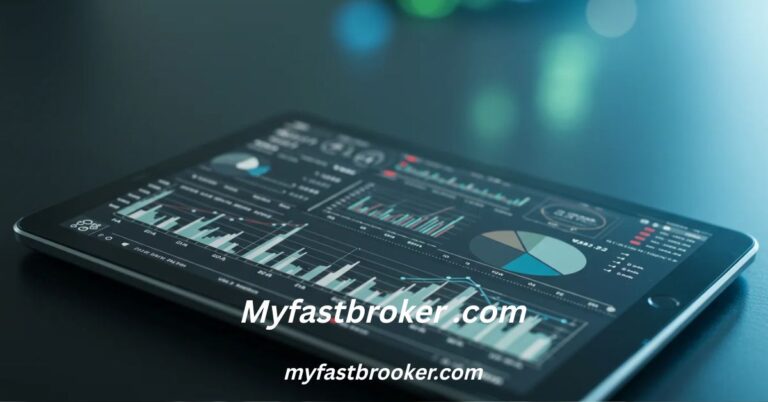Myfastbroker stock brokers — 2025 US Guide to Safety, Fees, and Smarter Choices
If you’ve been searching for myfastbroker stock brokers, you’ve probably seen a mix of glowing reviews, confusing claims, and many look-alike pages. This guide is here to cut through the noise. It explains what MyFastBroker appears to be, how it compares to established US brokerages, what to check before you sign up with any broker, and how to protect your money. You’ll leave with simple checklists, plain-English explanations, and practical next steps tailored for US readers. Where specific facts matter, I cite sources you can verify in a click.
What “myfastbroker stock brokers” actually means right now
From public pages, “MyFastBroker” looks less like a traditional, regulated US stock broker and more like a content/comparison hub or a broker-matching site that talks about many broker types (stock, mortgage, insurance, loans, forex, crypto). Its .com site frames itself as an informational resource that helps you find brokers and includes a disclaimer pointing US readers to the SEC and FINRA. That is the language of a comparison portal, not a firm that holds your cash or executes trades.
There’s also a .net site using marketing language about a “high-performance brokerage platform” that spans insurance, mortgages, and investments (including stocks, forex, and crypto). It reads like a broad “one-stop” finance pitch rather than a plain US brokerage disclosure. Treat this as promotional copy, not proof of US brokerage status.
Independent coverage is mixed and varies in quality. One recent third-party review points out that MyFastBroker.com does not clearly display major regulatory licenses (FCA, ASIC, CySEC), which is a red flag if you’re expecting a directly regulated broker. Take such claims as a prompt to verify, not as final truth.
Bottom line for US readers: treat MyFastBroker as a broker-matching or information portal. If you use it to “find” a stock broker, you must verify the actual broker you end up with: registration, protections, fees, and withdrawal policies. Use FINRA BrokerCheck and the SEC’s IAPD to confirm the company you will really be sending money to.

Why this matters: “portal vs. broker” changes your protections
If a site only introduces you to brokers, that site itself may not be a regulated broker-dealer or investment adviser. In the US, customer protections (SIPC coverage, segregation of fully paid securities, reserve requirements, etc.) apply at the broker-dealer you actually open the account with—not at an upstream “matching” portal. SIPC typically protects up to $500,000 per account category (including up to $250,000 in cash) if a SIPC-member broker fails—not for market losses.
US broker-dealers must follow the SEC’s Customer Protection Rule (Rule 15c3-3) and related requirements to safeguard customer assets. These rules are technical, but the simple idea is: your fully paid securities must be controlled/segregated, and firms must maintain reserves to protect customers. Recent SEC amendments increased certain reserve computations to daily for some firms—another reminder that the registered broker is where your legal protections live.
A simple playbook to evaluate any “myfastbroker stock brokers” recommendation (US)
- Find the real legal entity.
Who will actually custody your assets and execute trades? Get the broker’s full legal name and CRD/SEC number (the “match” site should disclose this). - Check registration in two minutes.
• FINRA BrokerCheck (all US broker-dealers and reps): search firm + CRD.
• SEC IAPD (investment advisers): search firm or individual; the site also links to BrokerCheck.
Look for current registrations, disclosures, and exam history. - Confirm SIPC membership.
Make sure the broker is a SIPC member so you have standard failure protection (again: this is not a loss guarantee). - Ask for pay-in, pay-out rules in writing.
Get the workflow and timeline for deposits and withdrawals, including any fees. If the “match” site pressures you to fund before you see the actual broker’s disclosures, stop. - Compare like-for-like pricing.
Line up the broker’s stock/ETF commissions, options contract fees, ECN/route fees, margin rates, and foreign market access. “Commission-free” often still includes other costs. If a portal claims “commission-free” but sends you to a broker with spreads or premiums, you’re still paying—just in a different way. - Check platform constraints.
Do you get full US market access, pre/post-market trading, options approval levels, and reliable tax reporting (1099s)? If options or OTC access matters, confirm in advance. - Know day-trading rules.
Under current FINRA rules, pattern day traders must keep at least $25,000 equity in a margin account to day trade frequently. If a broker or portal implies you can ignore that, be cautious and verify the firm’s policy. - Note red flags.
Be skeptical of mystery awards, vague badges, hard-sell popups, or testimonials without verifiable identities. These are common markers in scam education from US regulators.
The promise vs. the reality: what MyFastBroker pages say, and how to read them
Some MyFastBroker pages talk about stock, forex, and crypto access with “AI tools,” “risk controls,” and “education.” Treat these as marketing claims until you confirm the actual broker-dealer or exchange account that would hold your money. If a page presents itself as a portal that “helps you find” brokers and links to the SEC/FINRA, that is your hint that you are not dealing with a single, regulated US brokerage brand—yet. You still need to identify (and vet) the final landing broker.
A separate academy review notes the site does not clearly display big-name regulator licenses. That doesn’t automatically make it a scam, but it means you must perform the last-mile checks on whichever broker you choose through it.
If you’re in the US: safer pathways to a stock account
You absolutely can use a portal like MyFastBroker to research, but you don’t need a portal to open a US brokerage account. Many investors simply go straight to established US broker-dealers. To keep this guide neutral and evergreen, I won’t rank specific brands here. Instead, use this short checklist when you compare any US broker:
• Is it on FINRA BrokerCheck with active broker-dealer registration?
• Is it a SIPC member, and does the site clearly explain SIPC coverage?
• Does it clearly post commissions/fees and option contract costs?
• Are taxes and 1099s straightforward?
• How does the firm enforce the pattern day trader rule and margin calls?
• Can you reach human support quickly?
• Are there transparent policies for order routing and payment for order flow?
If a match-portal suggests a non-US broker for US residents, make sure the firm can legally onboard US persons and delivers proper tax forms. When in doubt, ask for written confirmation before you fund.
How to compare “myfastbroker stock brokers” with a US broker—by use case
Long-term index investor (buy and hold)
You mostly need low or zero commissions on stocks/ETFs, reliable tax forms, dividend reinvestment (DRIP), and rock-solid account protections. The lowest-effort path is a mainstream US broker-dealer with clear disclosures and easy 1099s. If a portal points you to a broker with spread-based pricing or offshore custody, ask yourself why you’d accept that for simple US ETF investing.
Options trader (covered calls, spreads)
Focus on per-contract fees, risk tools, options approval levels, and margin transparency. Some portals promote “advanced tools,” but you still need a US broker with stable greeks, strategy builders, and clear margin rules in writing.
Active day trader
Fast data, stable routing, hotkeys, and predictable fills matter more than hype. Confirm your broker’s PDT handling, intraday buying power, and cutoffs. If a portal implies you can skirt PDT or margin rules, that’s a red flag—US rules still apply.
International stocks or multi-asset
If you truly need foreign markets or forex/crypto alongside US stocks, check which regulated entities provide each leg of access and how your cash/securities are protected in each jurisdiction. Not all assets will sit under SIPC; protections vary.
Fees and pricing: read the full picture (even when it says “commission-free”)
“Commission-free” can still include:
• Wider spreads (you pay the difference).
• Marketable limit orders getting price improvement—or not.
• ECN/route fees for certain order types.
• Regulatory/clearing fees passed through to you.
• Currency conversion costs for international trading.
If a portal claims “commission-free stocks” next to “spreads on forex/crypto,” that’s normal in multi-asset marketing, but you still need to see the actual broker’s fee table. If the portal sells “premium analytics” for a monthly fee, make sure you’re not paying twice for data your eventual broker already includes. (A third-party review describes a hybrid pricing story and even a “premium” tier—but again, treat that as commentary until you see firm-level disclosures.)
Platform and tools: what matters more than buzzwords
Ignore generic claims about “AI” until you check these basics:
• Does the platform crash less during volatile sessions?
• Can you export trades and download tax documents anytime?
• Are pre- and post-market sessions supported?
• Do you get reliable options chains and greeks?
• Is there full mobile parity if you need it?
• Can you turn off “social” features you don’t want?
• Are there clear disclosures on payment for order flow and routing?
Many portals emphasize education and “beginner friendly” dashboards. That’s fine. Just make sure you’re not locked into a funnel that keeps you from picking the best US broker for your needs.
Safety: the quick checklist every US investor should run
Regulatory registration
Look up the firm on FINRA BrokerCheck (broker-dealer) and SEC IAPD (adviser). If it’s not there—or the name on your application doesn’t match—stop.
SIPC membership
Confirm SIPC coverage and what it does (and doesn’t) protect (it does not insure market losses).
Customer Protection Rule culture
All US carrying broker-dealers must follow Rule 15c3-3 for custody and reserves. If a salesperson cannot explain how your fully paid securities are controlled and how the reserve works, that’s a sign they don’t live this rule day to day.
PDT clarity
Ask for the firm’s written day-trading policy, especially if you’re close to the $25,000 threshold.
Vibes check
Be cautious with sites pushing hard to “fund now” with crypto or gift cards, showing mysterious trophies/badges, or listing anonymous testimonials. Those are well-known red flags.
Step-by-step: how a US investor can safely use a broker-matching portal
- Use the portal for research only at first.
- When you see a recommended stock broker, save the legal entity name (not just a brand).
- Verify that entity in FINRA BrokerCheck and IAPD. Screenshot the results for your records.
- Visit the broker’s own website (not just the portal’s page). Download the fee table, margin rate schedule, and options agreement.
- Email support and ask for the withdrawal policy (limits, timelines, fees) in writing.
- Start with a small deposit. Test a full cycle: deposit → trade → withdraw.
- Only then consider moving larger funds.
Practical templates you can copy
Email to confirm withdrawals
“Hello, I am a US customer considering opening an account. Before I proceed, please confirm in writing: (1) minimum/maximum withdrawal amounts, (2) typical processing times for ACH and wire, (3) any fees, and (4) any conditions that can delay a withdrawal. Thank you.”
Email to confirm PDT and margin
“Hello, I plan to day trade equities and options. Please share your written policy on the pattern day trader rule, intraday buying power, and how equity is calculated for PDT. If I fall below $25,000, what restrictions apply and for how long?”
When might a portal like MyFastBroker be useful?
• You’re brand-new and want a starting list of broker types.
• You need learning material before you pick a firm.
• You want to compare several brokers’ demos side by side (again, make sure the final broker is US-registered if you’re in the US).
• You’re exploring non-stock services (e.g., mortgages, insurance) and want a directory-style overview.
But if your goal is a plain US taxable brokerage account for buying US stocks and ETFs, going directly to a well-established US broker-dealer is often faster and clearer.
Advanced details (in simple words) US investors should know
Segregation of assets
US rules require carrying brokers to keep your fully paid securities in their possession or control and to maintain a reserve for customer funds. This isn’t optional; it’s the backbone of US brokerage safety.
What SIPC does and doesn’t do
SIPC helps if a member broker fails and your assets are missing. It does not protect market losses or bad advice. Some firms carry extra insurance, but that’s a bonus—not a substitute for strong controls.
Pattern day trader rule, briefly
If you day trade often in a margin account, you’re subject to the PDT rule: keep at least $25,000 equity or face trading limits. Discussions about changing this number come and go; until rules change, assume the current requirement applies.
Routing and “price improvement”
Brokers may route orders to venues that pay them (payment for order flow). That can still result in fair fills, but demand transparency and check your fill quality. If someone claims consistent “price improvement,” ask for the methodology behind those numbers.
My verdict on “myfastbroker stock brokers”
• Treat MyFastBroker as a research/matching layer, not as your final custodian. The .com site’s own “About/Disclaimer” reads like an information portal and even points you to SEC/FINRA resources. That is telling.
• The .net site’s broad “one-stop” finance language doesn’t replace verifiable US registrations. Marketing copy is not a license.
• A third-party academy review notes a lack of clearly displayed major regulator licenses. Take that as a nudge to double-check the actual broker you’d use.
If you want the simplest, safest route to buying US stocks, consider opening directly with a well-known, US-registered broker-dealer you can verify on BrokerCheck and SIPC’s site. If you do use a portal to compare options, run the “safety checklist” every time before you move money.
FAQs About Myfastbroker stock brokers
Is MyFastBroker itself a US-registered broker-dealer?
Public pages for the .com site read like a content/matching portal, not a carrying broker. Always verify the specific broker you’d actually open an account with using FINRA BrokerCheck and SEC IAPD.
Can a broker-matching site be helpful for US investors?
Yes—for education and shortlists. But protections (SIPC, custody rules) attach to the final US broker-dealer, not the matching site. Verify the destination firm before you fund.
What’s the fastest way to avoid trouble?
Get the broker’s legal name and CRD/SEC number, check BrokerCheck/IAPD, confirm SIPC membership, and test a small deposit/withdrawal cycle before you move larger money.
Do US day-trading rules apply no matter who a portal suggests?
Yes. If you’re trading US equities in a US margin account, the PDT rule applies at the broker-dealer level. If someone suggests you can bypass it, be cautious and confirm in writing.
What if a portal shows “Trusted By” badges I don’t recognize?
Generic awards and vague badges are a classic marketing tactic. US regulators advise skepticism toward unverified awards/testimonials. Verify before trusting.
How do I confirm my money is actually safe once I pick a broker?
Check BrokerCheck for the firm, confirm SIPC membership, read the firm’s disclosures on custody and margin, and understand the SEC Customer Protection Rule basics (the firm’s obligation to safeguard customer assets).
Does SIPC protect crypto?
No. SIPC covers securities and certain cash balances related to securities trades. Crypto held at a crypto exchange or in a crypto account is not covered by SIPC.






